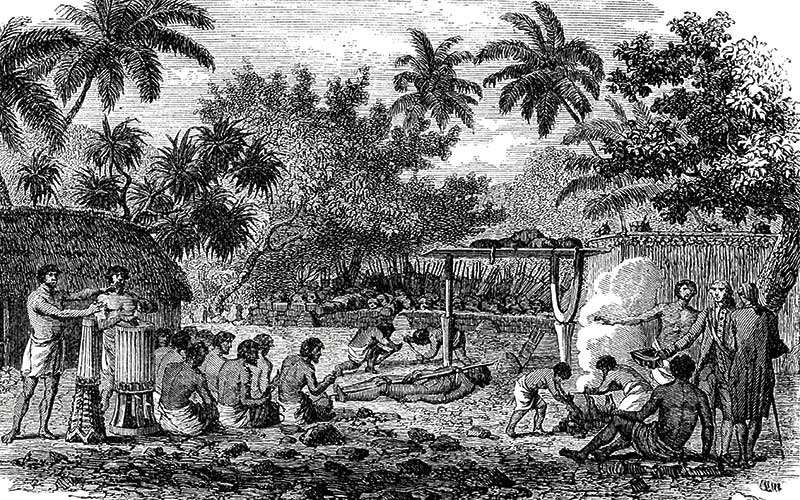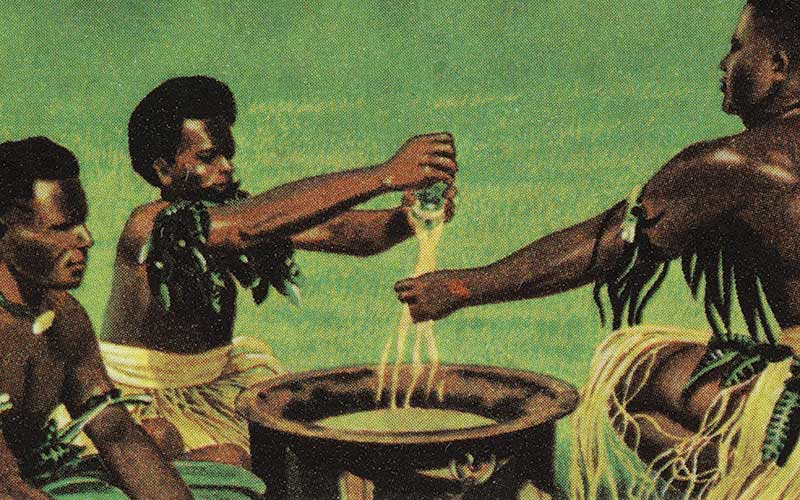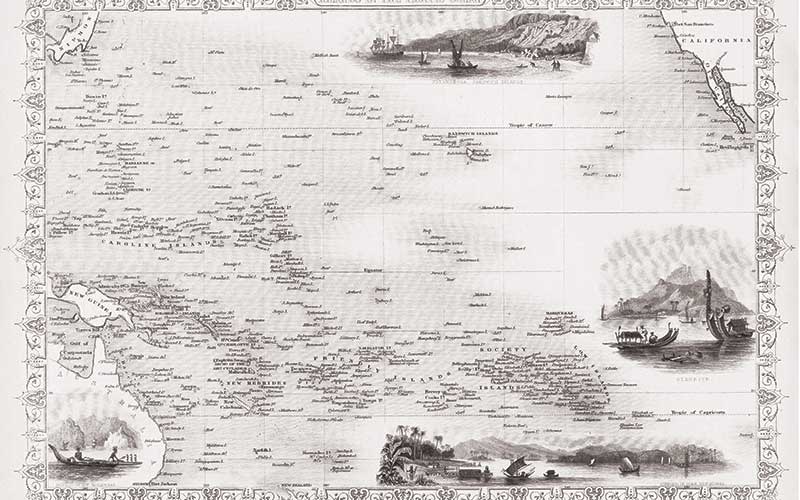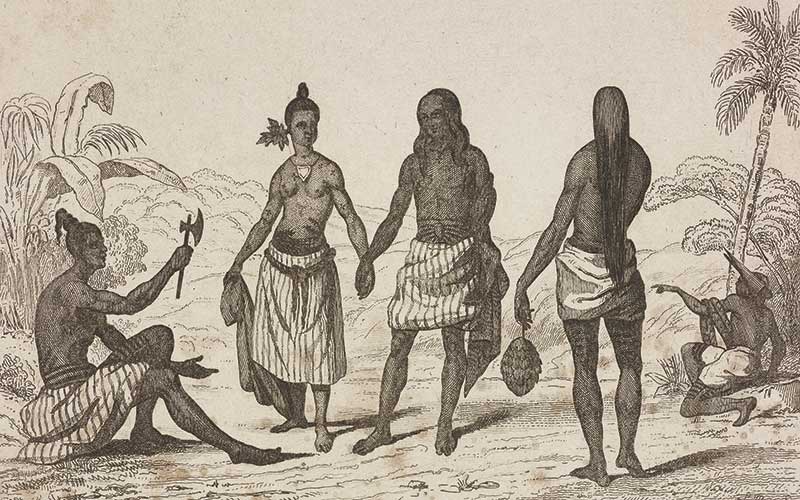The islands of Polynesia are known to be some of the most beautiful in the world, but the influence of the colonising West has left its indelible mark, writes Stephen Mortlock.

According to some genomic studies, around 800 to 900 BC, settlers from Southeast Asia migrated into the vast area of the Pacific Ocean called the Polynesian triangle (sometimes referred to as “Oceania”), which consists of three island groups, Micronesia, Melanesia and Polynesia.
The islands vary in size and type from tiny atolls only a few feet above sea level, to small tropical islands and vast volcanic islands. There is no doubt that these settlers were superb mariners, completing their voyages in large ocean-going canoes to the more distant and isolated islands, adapting to and mastering the numerous hazards of a marine environment. They took with them food, animals (pigs, chickens, dogs and unfortunately rats), seedlings and everything they would need to colonise new islands. Once settled they developed societies with a strict social organisation, including religion, food production, and most other facets of their culture.
Within these Pacific communities there were often diverse perceptions of health and disease and how they originate, from a divine punishment to interpersonal conflicts, natural disasters and supernatural insult all manifesting in some form of ill health, like many parts of Europe at the time they did not consider biological agents, such as bacteria and viruses, as the causes of disease. If a person got sick, he might conclude a spirit was displeased with his or one of his relative’s behaviour. Or perhaps he was suffering from a hidden guilt or secret wrongdoing. He might even suspect another individual of hexing him with sorcery. Although this may be seen as an ancient belief, it is still considered valid in some communities.
But the islanders do seem to share two health fundamentals: a holistic notion of health and health as a family concern, rather than an individual matter. During this time, they developed strong social mechanisms for coping with the human problems of shipwreck, to help support separated families with the sudden loss of large numbers of the group.
 Polynesian culture
Polynesian culture

In pre-colonial times, records show that health in most of the Pacific Islands was good, compared with that of Europe.
Certainly it seems that all Polynesians had a healthy appreciation for bathing, using certain leaves which lathered like soap and wadded fibres from coconut husks and other plants to scrub themselves. Communicable diseases between the islands was rare, but once introduced could easily become epidemic. When Europeans first came into contact with Polynesians, the islanders had never previously been exposed to diseases such as measles, influenza and syphilis, which later decimated whole populations and jumped from island to island. Contemporary records do suggest however, that there were a number of tropical diseases endemic on the islands including, filariasis, malaria, dengue and scrofula.
Most Polynesian societies had special healers and the ability to heal was considered a reward and most healers were not paid but instead “gifted” with presents of gratitude and status, such as food, household furniture, or clothing. In 1806, the British privateer vessel Port-au-Prince, was seized and stripped of all valuables by the islanders, while it was anchored off the Tongan island of Lifuka. Only four crew survived including the ship’s clerk 15-year-old William Mariner who became the chief’s adopted son taking the name Toki ‘Ukamea.
He lived on the islands for four years until he returned to the UK and dictated a detailed account of his experiences of Tongan society and some of the traditional healing techniques, which included ritual amputation, mutilation and even sacrifice as part of the healing process. He himself witnessed two five-year-old children competing for the privilege of undergoing the amputation of a finger for a sick relative.
The removed finger was wrapped in unfinished tapa (cloth made from the bark of the paper mulberry) then taken to a priest or priestess to affect a cure. For the more serious illnesses, the family might resort to human sacrifice. The chosen victim was generally of a lower rank than the sick individual and they were garotted by the family members with strips of tapa. The supplicants would then take the sacrifice to the priest or priestess who waited at a sacred house.
Once they had received the sacrifice they would enter a trance-like state, with violent convulsions when they became possessed and the god’s will would be communicated through revelation and prophecy and the illness would be gone. If the person did not get better it was assumed that the god must have changed his mind or had intentionally deceived them.
In Polynesian myths, plants, fruits and vegetables came from human bodies and as a consequence humans and plants are linked. Due to this, healers throughout Polynesia thought that plant medicines in the form of potions and applications were the best remedy to cure diseases, as illness was considered an alien fluid that upset the balance of the body. Acquaintance with plants and their properties was, and still is, widely used and often quite sophisticated; a study identified over 50 different indigenous plants that were used in the treatment of diseases. Most commonly,
the healer would prepare these medicines from these selected plants by pounding the material in a wooden bowl and straining the juice. Sometimes the juice would be sweetened with sugar cane sap, and drunk with water, inhaled or applied to an injury.
Throughout Polynesia, islanders have used the juice of the Noni tree (Morinda citrifolia L. Rubiaceae) in a variety of medicinal preparations and as a famine food, it is assumed to have originated in Southeast Asia and subsequently distributed to the islands of the Western Pacific. Noni is now becoming an increasingly popular wellness drink in North America, Europe and Australia, and has been promoted as a treatment for a vast array of medical conditions, ranging from cancer to sexual dysfunction.
Roots of the Kava plant (Piper methysticum) were crushed and drunk to relieve headaches, tension and sleeplessness, while in Hawaii a kava poultice was used to stop toothache. Certainly, over centuries, kava has been used in the traditional medicine of the South Pacific Islands for urogenital conditions (gonorrhea infections and cystitis), reproductive and women’s health issues. Along with tropical staples, such as yam (Dioscorea spp.) and taro (Colocasia spp.; Alocasia spp.), kava grows throughout much of the tropical Pacific. Polynesians, many Melanesians, and some Micronesians used the plant historically, and large numbers continue to do so today.
Modern techniques have identified the active ingredients as a class of lactone compounds: the Kavalactones, which seem to have the potential for various psychotropic effects, including an anti-anxiety and sedative/hypnotic activities. Raw kukui or candlenuts (Aleurites moluccanus) were eaten as a laxative in Hawaii and in Tonga women scraped the bark of the kukui tree to derive sap which was applied to the tongue and mouth of children with fungal infections. Mashed candlebush (Senna alata) leaves are still used today to eliminate ringworm and other skin rashes. The leaves are ground in a mortar to obtain a kind of “green cotton wool”. This is mixed with vegetable oil and rubbed on the affected area two or three times a day. Its active ingredients include chrysophanic acid, which has very effective fungicidal properties. Senna pods also contain anthraquinone, which has a well-proven laxative effect. The roots of the monarch fern (Phymatosorus scolopendria) or Laua’e were boiled and the mixture cooled and used to bathe babies to cool fevers. Fijians and Hawaiians would clean, pound and mix turmeric root with hot water, which was then strained and squeezed to produce a juice that was administered to relieve diabetes and coughs. The people of Rapa Nui, or Easter Island, would use sweet potatoes to quench their thirst, while Hawaiian women used the vines as a necklace to ensure an abundant flow of breast milk. The juice of the moist husk of green coconuts was squeezed and administered to newborn babies to clear their systems of “womb” food, while coconut oil scented with fragrant leaves and flowers was used in massaging for aches, pains, injuries, vitality, and beauty.
Certain islands also produced a love potion, “Omung”, said to made from crushed stingray tail, black ants and centipede legs, the over-use of which could lead to madness and hysteria.
 Western influence
Western influence

Prior to outside influences, there was thriving culture in many parts of Polynesia, with its own governments, language, and religion. However, in the sixteenth century, contact with the outside world began and some islands became early stopping points for voyagers, while others remained almost untouched well into the twentieth century. Unfortunately, even the friendliest visitor could precipitate radical changes in these societies, as some of the visitors judged the native ways of life based on Western standards and tried to change the indigenous systems, which led to conflicts and caused some elements of their culture to be lost. Early accounts by Jean-Francois Surveille’s expedition of 1769 regarded the Polynesians as “extremely dirty with skin diseases and a type of scab or itch”. While one voyager explained that Melanesia was generally unhealthy for human habitation because there were “plagues of insect pests and their attendant ills... that deface the skin… and poison the blood”.
In contrast, the explorer James Cook wrote in 1774 that the Marquesans were “the finest race ever beheld… tall and well proportioned”. While in 1795 James Mortlock of the ship Young William on a two-year voyage from London to China (via Australia) described the health of the Mortlock Islanders as good, as he noted that they had a physical strength and healthy appearance, with “strong white teeth” and “smooth skins”.
But European contact introduced many diseases which transformed what was a balanced, if occasionally precarious, existence into situations of dramatic population decline.
A single measles epidemic in 1866 killed thousands in Vanuatu, and one in 1875 is estimated to have reduced the population of Fiji by a third. Measles was particularly dangerous on isolated islands because a large proportion of the adult population were simultaneously ill, leaving few to care for the sick. Smallpox was largely contained by quarantine efforts to Hawaii, Guam, the Caroline Islands, French Polynesia and Papua New Guinea. There was the smallpox epidemic that first broke out in Pohnpei in 1854. When the American whaleship Delta came to anchor off the island, it put ashore two of its crew members who had contracted smallpox during the voyage and they buried another victim. According to the remaining crew the Pohnpeians stripped the diseased men of their clothes and, according to one version of the tale, dug up the body of the other.
The result was a severe outbreak of the disease, which raged through the island for several months and killed half the population in just five months.
In 1854, 2,000 of 5,000 persons died on the Caroline Islands from smallpox, and a third of the population of Guam perished in 1856. There were still other devastating smallpox epidemics along the northern coast of New Guinea in 1872 to 1895 during the German colonial establishment of a plantation economy.
The arrival of these ships also brought with them influenza and dysentery. Tahiti recorded a lethal dysentery outbreak following the arrival of the Vancouver in 1792 and again in 1807 after the whaler Britania visited. In 1804, a dysentery epidemic in Hawaii is said to have killed so many (estimates range from 5,000 to 15,000) that the living were unable to bury the dead. Records from 1890 suggest that dysentery was a common problem on contract labour ships sailing between the islands and was probably spread from ships’ crews to the indigenous population. Half of those infected died within 10 days. Benjamin Snow, the resident American missionary on Kosrae, lamented the rate at which “our benighted people sicken and die” with influenza. In 1854, two years after his arrival, he remarked that “Hardly a week and sometimes hardly a day passes without hearing that someone has died.” In 50 years, the population of Kosrae declined by 90% – a loss comparable to that suffered by the Marianas over a century earlier. Reports from American missionaries in the Marshalls around the mid-19th century had a familiar ring to them. On Ebon in 1859, influenza broke out; the disease “has worked its way into the lungs, and a number of the people have died of bronchitis”. In a single month, the island of only a thousand lost a hundred people. There was another outbreak of influenza there just two years later. Lethal influenza outbreaks with secondary bacterial pneumonia were particularly apparent on the Pacific Islands in 1890 and during the 1918–1920 pandemic, contributing to the devastating mortality on Fiji, Nauru, Samoa, Saipan and Hawaii. There were also epidemics of TB and typhoid which devastated the Marquesas from 1791 to 1863-64, when 80% of the population died.
 Modern problems
Modern problems

Over the years, the Polynesians have raised many questions about their culture from the oldest known human settlement on Samoa located two metres below sea level, where they found elaborate Lapita pottery shards from around 1000 BC, to the giant Moai of the Easter Islands and the stone money of Yap Island. Illnesses and diseases have emerged in Pacific countries since European intrusion, but fortunately the predicted demise of the Polynesian race, widely anticipated through the nineteenth century by Alfred Tetens, has not happened.
During the twentieth century, public health measures served to reverse population decline, and high fertility led to rapid population growth, which has now brought its own threat to the region. But the legacy of morbidity and mortality from introduced diseases still remains. More recently the traditional diet of the region has been replaced by canned fish, biscuits, white flour products, and sugar-laden food. Purchasing imported food goods has for some become a sign of social status in some communities, and traditional foods have decreased in importance. Though malaria is still the primary cause of death in Vanuatu, diabetes, hypertension, obesity and coronary heart disease are now prime health concerns in some Pacific countries.
Dr Waqanivalu, Technical Officer for Nutrition and Physical Activity at the Office of the WHO representative for the South Pacific, certainly blames poor diet for many of the region’s health problems, where the consumption of traditional foods has declined. More importantly micronutrient deficiencies have become common in this region, with more than one-fifth of children and pregnant women showing signs of anaemia. In Fiji and the Solomon Islands, surveys have indicated alarming levels of diet-related disease, and health education campaigns have been introduced to highlight the need for nutrition through community participation and integrated health programmes, including salt iodization to reduce iodine deficiency and related goitre.
Today, some form of environmental disaster always seems just over the horizon, and certainly the socio-ecological systems of Polynesia are being threatened by the rapid changes in an increasingly globalised world with destruction of the rainforests, the overexploitation of the oceans, industrial and agricultural pollution, the growing volume of toxic waste products and plastics, climate change and the loss of biodiversity and human diversity. There are no new islands to discover and as a people we need to learn how to conserve resources and control population growth within the limits of the Earth.
Dr Stephen Mortlock is Pathology Manager at the Nuffield Health Guildford Hospital. He would like to thank the matron and all the staff at Nuffield Health, Guildford Hospital, for their continued support.
Image Credit | Bridgeman / Alamy / iStock / Shutterstock
References
Bushnell, O. A., 1966. “Hygiene and Sanitation Among the Ancient Hawaiians.” Hawaii Historical Review 2, no. 5, pp. 316–336.
Chun, Malcolm Naea, 1986. Hawaiian Medicine Book, He Buke Laau Lapaau. Honolulu: The Bess Press.
Goldie, William H., 1899. Polynesian Medical Researches. Edinburgh: Thesis, University of Edinburgh.
Green, Laura S., and Mary Kawena Pukui, l936. The Legend of Kawelo and other Hawaiian Folk Tales. Honolulu: Territory of Hawaii.
Gutmanis, June, l977. Kahuna La’au Lapa’au: The Practice of Hawaiian Herbal Medicine. Honolulu: Island Heritage.
Handy, E. S. C.; Mary Kawena Pukui; and Katherine Livermore, 1934. Outline of Hawaiian Physical Therapeutics. Honolulu: Bishop Museum Press.
Judd, Laura Fish, 1928. Honolulu: Sketches of the Life Social, Political, and Religious in the Hawaiian Islands From 1828 to 1861. Honolulu: Honolulu Star-Bulletin.
Kimura, Larry, 1966. “Kahuna Lapa’au.” Hawaii Historical Review, no. 2, pp. 273–275.
Lange, Raeburn, 1986. “Changes in Rarotongan Attitudes toward Health and Disease: Historical Factors in the Development of a Mid-Twentieth-Century Understanding.” Pacific Studies, Volume 10, Number 1, pp. 29–53.
Larsen, Nils P., 1944. “Medical Art in Ancient Hawaii.” Hawaiian Historical Society, Report, pp. 27–44.
Monberg, Torben, 1966. The Religion of Bellona Island: A Study of the Place of Beliefs and Rites in the Social Life of Pre-Christian Bellona, Part 1: The Concepts of Supernaturals (Language and Culture of Rennell and Bellona Islands: Volume II, Part 1). Copenhagen: The National Museum of Denmark.
Moyle, Richard M., 1974. “Samoan Medicinal Incantations.” The Journal of the Polynesian Society Volume 83, no. 2, pp. 155–179.
Oliver, Douglas L., 1974. Ancient Tahitian Society. Honolulu: The University Press of Hawaii.
Parsons, Claire D. F. (ed.), 1985. Healing Practices in the South Pacific. Lâ’ie: The Institute for Polynesian Studies.
Rutherford, Noel (ed.), 1977. Friendly Islands: A History of Tonga. Melbourne: Oxford University Press.
Spencer, Dorothy May, 1941. Disease, Religion and Society in the Fiji Islands. Seattle: University of Washington Press.
Stevenson, Robert Louis, 1971. In the South Seas, Pacific Classics. Honolulu: University of Hawaii Press.
Weiner, Michael A., 1971. “Ethnomedicine in Tonga.” Economic Botany, Volume 25, no. 4, pp. 423–450.
Su, B., Jin, L., Underhill, P., Martinson, J., Saha, N., McGarvey, S. T. et al. (2000). Polynesian origins: Insights from the Y chromosome. Proceedings of the National Academy of Sciences of the United States of America, 97(15), 8225–8228.
Penman, b. S., s. Gupta, and g. D. Shanks. “Rapid Mortality Transition of Pacific Islands in the 19th Century.” Epidemiology and Infection 145.1 (2017): 1–11. PMC. Web. 27 Apr. 2018.
Fitzpatrick-Nietschmann, J. (1983). Pacific Islanders—Migration and Health. Western Journal of Medicine, 139(6), 848–853.
Martin, P. M., & Combes, C. (1996). Emerging infectious diseases and the depopulation of French Polynesia in the 19th century. Emerging Infectious Diseases, 2(4), 359–361.
Shanks GD. (2016) ‘Lethality of First Contact Dysentery Epidemics on Pacific Islands.’ Am J Trop Med Hyg. 95: 273-277
